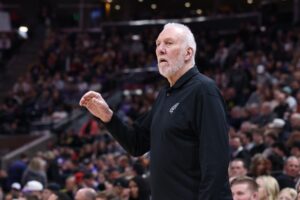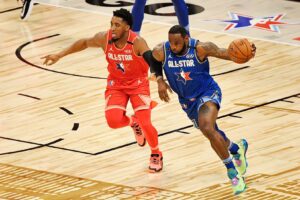Collegiate coaches have two major goals in any scenario: Prepare the athletes for the NBA and ensure the program has some semblance of a culture. One of the best examples of this at play is during the 1997 National Championship Game. Kentucky Wildcats forward Derek Anderson missed most of the season due to an ACL injury but was cleared to play in the game. Head coach Rick Pitino made a controversial decision to sit Anderson to ensure his health for his future NBA career and to avoid re-injuring his knee.
That decision is still met with criticism, as Anderson could have provided the team with a boost to win the championship. However, he might have ruined his playing career in the NBA by further aggravating his damaged knee. Although this example is specific and a bit dated, the relevance to how college programs are creating a culture with one-and-done recruits is similar.
University of Kentucky Faces a One-and-Done Problem
University of Kentucky Needs to Establish a Culture
Ask any Kentucky fan about missed championships and they’ll more than likely reference the 1997 season. Fans of any sport have the idea of loyalty to the college, team, sport, or the specific game. Kentucky is a top recruiting program as most of its high-level players end up being selected in the first round of the NBA draft. This results in deep tournament runs and better chances at titles, but where does it leave the program? Since John Calipari took over as head coach, the one-and-done is a prominent recruiting strategy at Kentucky. This shows in the school’s record, 249-52 since 2009. Comparatively, a program that doesn’t utilize one-and-done nearly as often as Kentucky is Duke University, which is 238-56 under Mike Krzyzewski. The Blue Devils have won two national championships under Krzyzewski, whereas Kentucky has only one in that span. What does this prove?
One-and-Done vs. Buying In
Kentucky this season has a new cast of high-caliber freshmen as it does nearly every year. No more than two seniors at a time have been active in the depth chart in this Calipari era. The young recruits are the focal point of this culture. The one-and-done player is highly recruited for a better opportunity to win a championship, but the downsides can outweigh success. Fans want loyalty out of their players, but more so the coach at this level. College athletes aren’t getting paid, so leaving for the draft isn’t seen as a selfish decision. But when a coach like Calipari recruits these players to leave in just one season, it’s hard to swallow. The fans, alumni, and donors want to know that the coach is doing what is right for the program as well as the players.
Kentucky’s Mixed Success
The choice to pursue the one-and-done player has to yield some rate of success but also actively answers the off-season questions. What are the downsides to this process? This idea must be re-evaluated each season in which a championship or a great amount of success isn’t attained. Kentucky won one national title in 2011 with Anthony Davis and immediately missed the tournament altogether the next season. The Wildcats were the runner-up in 2014 but have not been to the championship game in any other season. This highlights the downside to the one-and-done method, as programs like Duke recruit traditionally and find more success in the tournament.
However, for Kentucky fans, the discussion is identical each year: Who is that player and is he staying next season? The real downside to only keeping recruits for one season is the lack of awareness by fans. Some don’t care to learn names or information because “they’ll be gone next year anyway.”
The Future for Kentucky Basketball
Kentucky fans have long lived with the history of winning. This history maintains due to the recruiting process that Calipari has embedded into the program, but at what cost? When is it time to abandon this idea in favor of a more traditional approach to building a three- or four-year team? How much longer can fans keep up the façade of dedication when they have no feelings invested into these players? They ran off former coach Tubby Smith for the exact opposite approach of building four-year teams with no result. So, what’s the timeframe for Calipari to prove his method before he must find a new job? Regardless of the choices that the Wildcats make in the coming years, the demand for success always runs high in the state of Kentucky.
Main Photo:
Embed from Getty Images






